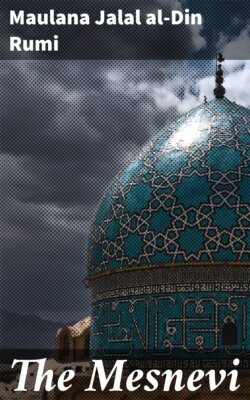Читать книгу The Mesnevi - Maulana Jalal al-Din Rumi - Страница 98
На сайте Литреса книга снята с продажи.
76.
ОглавлениеIn the time of Sultan Veled (A.D. 1284-1312), a young man, of the descendants of the Prophet, and son of the guardian of the holy tomb of Muhammed at Medīna, came to Qonya with a company of his fellow-descendants, belonging to that city. He was presented to Sultan Veled, and became his disciple.
He wore a most singular head-dress. One end of his turban hung down in front to below his navel; while the other end was formed into the sheker-āvīz19 of the Mevlevī dervishes.
When they had become somewhat intimate, Sultan Veled asked him how it happened that he wore the sheker-āvīz of the Mevlevis, when nobody else but those dervishes wear it, in imitation of their founder, Jelāl.
The young man explained that his family were descended from the Prophet. That the Prophet, on the night of his ascension to heaven, after seeing God and many mysteries, had returned a certain distance, and, as is well known, then went back to intercede with God for his people. He now perceived, on the pinnacle of God’s throne, the ideal portrait of a form, so beautiful, that he had not hitherto witnessed anything so charming among the angels and inhabitants of heaven.
After contemplating the lovely vision, in amazement, for some time, Muhammed was able to notice that the ideal form wore on its head a sheker-āvīz. He asked Gabriel what that ideal portrait might portend, which was so attractive in its beauty as to surpass all the wonders he had witnessed in all the nine heavens. “Is it the portrait of an angel, a prophet, or a saint?” Gabriel replied: “It is the portrait of a personage of the descendants of Abū-Bekr, who will appear in the latter days among the people of thy Church, and will fill the whole world with the effulgence of the knowledge of thy mysteries. To him will God vouchsafe a precedency, and a pen, and a breath, such that kings and princes will profess themselves his disciples; and he will be a most pure upholder of thy religion, being, in every respect, the counterpart of thyself in aspect and in morals. His name will be Muhammed, as is thine; and his surname will be Jelālu-’d-Dīn. His words will explain thy sayings, and will expound thy Qur’ān.”
On his return home, the Prophet adopted the form of turban he had seen worn in that ideal portrait, making one end hang down a span in front, and binding the other end behind into a sheker-āvīz.
“From that day to this,” said the young man, “the fathers of our family have followed that fashion, so adopted by the Prophet; and we continue to do so too.”
It is said that when Abū-Bekr heard this narrative from the Prophet, respecting his great descendant that was thus foretold, he gave the whole of his possessions to the Prophet, to be expended in God’s cause.
When Muhammed died, Abū-Bekr wept long and bitterly. But the Prophet appeared to him, and consoled him by saying: “One day I will reappear among my people from out of the collar of one of thy race.”
The young man continued: “From that time onwards, our family were on the outlook for the manifestation of the holy personage whose ideal portrait the Prophet so saw. Thank God that I have witnessed the realisation of their hope.”
The Qonya pilgrims published this communication to all the disciples there present.
